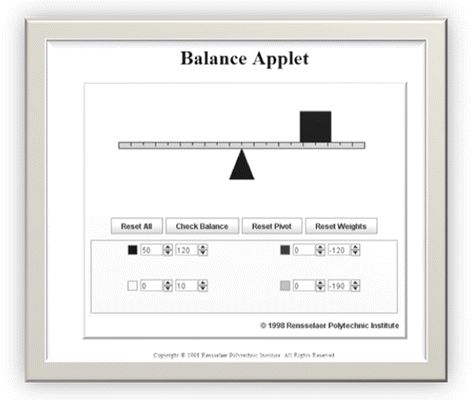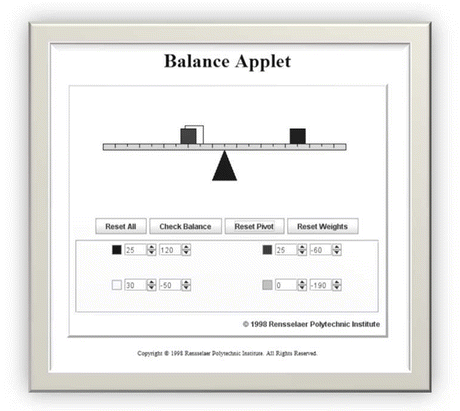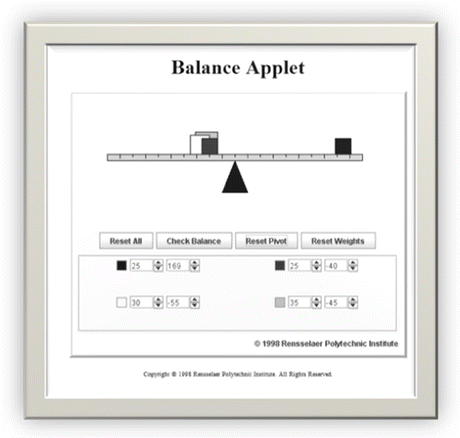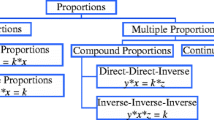Abstract
Our study was enacted in university mathematics education classes in the USA with preservice teachers (PSTs). This research focused on PSTs’ interview responses that were used to assess their understanding of balance when challenged with tasks involving virtual manipulatives. Siegler’s rules were used in analyzing PSTs’ responses to balance tasks to help determine each PST’s level of abstraction achieved regarding balance, equilibrium, or equivalence. Specifically, the data were analyzed regarding 3 different aspects: (a) the PSTs’ understanding of balance, (b) what previous knowledge was exhibited by the PSTs throughout the enactment of the tasks, and (c) the mathematics utilized by the PSTs as they problem-solved with the virtual balance applet. The results showed PSTs relying on visual cues to implement procedures that were often inappropriate for the task at hand. When confronted with missing value balance tasks, 47 % of the PSTs attempted an incorrect procedure using direct proportions, and some (35 %) employed an incorrect fractional method. One PST systematically solved tasks, where he invented an inverse proportions model. However, most interviewees relied on guess-and-check reasoning. Implications of this study advise the need for purposeful experiences within education programs that lead to better connections across disciplines of big ideas such as balance.
Similar content being viewed by others
References
Bhattacharyya, S. & Bhattacharyya, K. (2009). Technology-integrated project-based approach in science education: A qualitative study of in-service teachers’ learning experiences. Electronic Journal of Science Education, 13(3), 1–26.
Boaler, J. (2002). Experiencing school mathematics: traditional and reform approaches to teaching and their impact on student learning (Volume in the Studies in Mathematical Thinking and Learning Series). Mahwah, New Jersey: Erlbaum Associates, Inc.
College and Career Readiness Standards for Mathematics (2009) Overview of the mathematical practice standard. Retrieved on 17 March 2010 from http://www.corestandards.org/Standards/index.htm.
Duckworth, E. (1996). “The having of wonderful ideas” and other essays on teaching and learning. New York: Teachers College Press.
Inhelder, B., & Piaget, J. (1958). The growth of logical thinking from childhood to adolescence. (A. Parsons, translated). New York: Basic Books.
Klahr, D. & Siegler, R. (1978). The representation of children’s knowledge. In H. Reese & L. Lipsitt (Eds.), Advances in child development and behavior, 12 (pp. 61–116). New York: Academic.
Louisell, R., Wilhelm, J., Kazemek, F. (2011). What children’s conceptions of shadows teach us about the nature of children’s thinking. Paper presented at the 21st European Early Childhood Education Research Association (EECERA) Annual Conference “Education from birth: Research, practices, and educational policy”. August 2011, Geneva, Switzerland.
Mason, J. & Spence, M. (1999). Beyond mere knowledge of mathematics: The importance of knowing to act in the moment. Educational Studies in Mathematics, 38, 135–161.
Merriam, S. B. (2009). Qualitative research: A guide to design and implementation. San Francisco, CA: Jossey-Bass.
National Council of Teachers of Mathematics (2000). Principles and standards for school mathematics. Reston, VA: NCTM.
National Council of Teachers of Mathematics (2006). Curriculum focal points for prekindergarten through grade 8 mathematics: A quest for coherence. Reston, VA: NCTM.
National Research Council (1996). National science education standards. Washington, DC: National Academy Press.
Rensselaer Polytechnic Institute (1998) Balance Applet. Retrieved 25 February 2009 from http://www.ibiblio.org/links/applets/appindex/balance.html.
Serway, R. & Faughn, J. (1995). College physics (4th ed.). Orlando, FL: Harcourt Brace.
Shen, J. (2006). Understanding balance: Tool or model? Proceedings of the Annual Meeting of National Association for Research in Science Teaching (NARST). San Francisco, CA.
Siegler, R. S. (1976). Three aspects of cognitive development. Cognitive Psychology, 8, 481–520.
United Nations (2010). The world’s women 2010: Trends and statistics. New York: Department of Economic and Social Affairs.
Van Dooren, W., De Bock, D., Evers, M. & Verschaffel, L. (2009). Students’ overuse of proportionality on missing-value problems. Journal for Research in Mathematics Education, 40(2), 187–211.
Wiggins, G. & McTighe, J. (2005). Understanding by design. Alexandria, VA: ASCD.
Wilhelm, J., Sherrod, S. & Walters, K. (2008). Experiencing project-based learning environments: Challenging pre-service teachers to act in the moment. The Journal of Educational Research, 101(4), 220–233.
Author information
Authors and Affiliations
Corresponding author
Appendix
Appendix
Clinical Interview Protocol—Developed by the author, 2009
Name________________________ Date______________
Balance Exploration Using an Interactive Applet
-
1.
Where should I add one weight, so the board would be balanced? (note: Weight is shown in the first box and position is shown in the second box. For example, the object in the figure below has a weight of 50 units and a position of 120 units).

-
2.
The following board is balanced.

If I move the blue (shown above as dark black) object 30 units to the right, how would I have to move either the red (shown above as light black) or the yellow (shown above as white) object in order to maintain balance?
-
3.
The following board is balanced.

If we were to move the blue (shown above as dark black) weight 100 units to the left, how would we need to move one of the other three weights to maintain balance?
Rights and permissions
About this article
Cite this article
Wilhelm, J., Matteson, S. & She, X. INVESTIGATING PRESERVICE TEACHERS’ UNDERSTANDING OF BALANCE CONCEPTS UTILIZING A CLINICAL INTERVIEW METHOD AND A VIRTUAL TOOL. Int J of Sci and Math Educ 11, 1209–1231 (2013). https://doi.org/10.1007/s10763-012-9371-y
Received:
Accepted:
Published:
Issue Date:
DOI: https://doi.org/10.1007/s10763-012-9371-y







